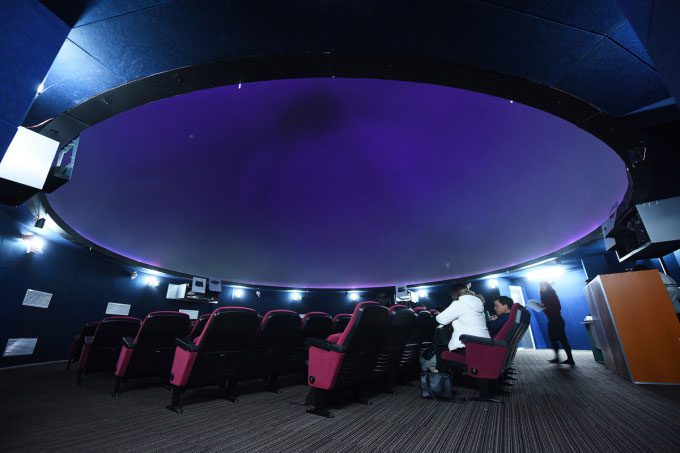The last total lunar eclipse of this year will reach its peak at 5:59 PM on November 8 (Hanoi time). In Vietnam, it can be observed from locations facing east.
The lunar eclipse process will begin at 3:02 PM, with the total phase occurring at 5:16 PM and lasting approximately 85 minutes. According to experts, any area in Vietnam with an unobstructed view to the east will be able to observe the eclipse well.
In Ho Chi Minh City, the Amateur Astronomers Club (HAAC) plans to organize a viewing of the total lunar eclipse at Bach Dang Park (District 1), starting at 5 PM. According to Nguyen Anh Tuan, Chairman of HAAC, the location at Bach Dang Park offers an unobstructed view to the east, making it very easy to observe the eclipse.
Watch the total lunar eclipse live here.
“The total lunar eclipse occurs just as the Moon rises in the east, right at the horizon. However, to observe this phenomenon best, the weather must be clear, without clouds or rain,” Tuan said.
Observing the lunar eclipse can be done with the naked eye or binoculars. On the afternoon of November 8, HAAC plans to bring several specialized telescopes to help the public observe the event optimally.
In Ho Chi Minh City, at 5:22 PM, the Moon will be completely in the total phase and will appear a deep red color. Observers can see the blood-red Moon slowly rising from the eastern horizon. At 5:59 PM will be the peak of the total lunar eclipse when the Moon will be at its darkest red color. However, at this time, the Moon will be at an altitude of 7.6 degrees, still relatively low on the eastern horizon. The total lunar eclipse will end at 6:41 PM when the Moon gradually rises higher, completing the total phase at an altitude of 17.4 degrees, which is quite favorable for observation.
After 6:41 PM, the Moon will transition to a partial lunar eclipse, with the part not covered by the Earth’s shadow gradually becoming visible and ending 8 minutes later. In other localities, the timing may vary slightly but is not significant.

An astronomy observation event in Ho Chi Minh City organized by the Amateur Astronomers Club. (Photo: HAAC)
In Hanoi, many amateur astronomy groups are also preparing for the observation and photography of this phenomenon.
Dr. Le Xuan Huy, Deputy General Director of the Vietnam Space Center, stated that at the Hoa Lac Space Observatory, they will organize a sky observation for 70 third-grade students using telescopes during the lunar eclipse. Prior to this, the students will also learn about telescopes, how to make them, and other knowledge about space and fascinating astronomical phenomena.

The dome-shaped planetarium at the Hoa Lac Observatory – where students will learn about astronomy and space. (Photo: Giang Huy)
Nguyen Tran Ha (Hanoi), an amateur astronomy enthusiast, is also preparing for observation and photography when the Moon is completely obscured.
He noted that the total lunar eclipse occurs early, so the Moon will be low in position and may be obstructed by buildings, making it difficult to observe in large cities. In the latter half of the peak, observation will be better as the Moon gradually rises higher. This means around 6:30 PM and onward, the angle will reach about 18-20 degrees above the horizon. At this time, the Moon will also appear brighter.
Tran Ha mentioned another fascinating phenomenon during the total phase: the Moon will pass and obscure the planet Uranus. Right after the total lunar eclipse phase ends (at 6:45 PM), Uranus will emerge on the other side of the Moon’s disk. “If you have a good enough telescope, you can observe the phenomenon of Uranus appearing, which is amazing,” Tran Ha said.
Worldwide, from Iceland, areas in South America, South Asia, Central Asia, and Russia can observe a partial lunar eclipse on November 8. Meanwhile, North America and many places in South America, Asia, Australia, and New Zealand will be able to witness a total lunar eclipse.
This will be the second and final lunar eclipse of 2022. The previous lunar eclipse occurred on May 16. In 2023, there will also be two lunar eclipses in May and October. A lunar eclipse occurs when the Earth moves between the Moon and the Sun. At that time, the Earth casts its shadow on the Moon. The shadow of the blue planet can completely (total lunar eclipse) or partially (partial lunar eclipse) block sunlight and cause the Moon to darken.
During a lunar eclipse, the Moon can take on a red hue because sunlight, even though directly blocked by the umbra (the darkest part of the Earth’s shadow), bends around the blue planet and travels through the atmosphere to reach the Moon. The Earth’s atmosphere filters out shorter wavelengths of blue light and allows longer red and orange wavelengths to pass through. When these red and orange wavelengths pass through the Earth’s atmosphere, they continue to reach the Moon. This phenomenon of the Moon appearing red is called a Blood Moon.


















































